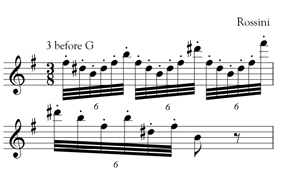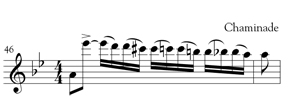Keith Underwood’s masterclasses are a study in creative teaching techniques that simultaneously involve, inform, and entertain attendees with their unorthodox, yet effective, methods. Underwood’s fascination with the mechanics of flute playing, particularly the playing of flutists such as Jean-Pierre Rampal, Julius Baker, and James Galway, has led Underwood to develop many innovative ideas. In addition, he often adapts concepts from the pedagogy of brass and other instruments.
Underwood has been an active flutist and educator in New York for three decades. He has taught and performed in Japan, Mexico, Italy, Brazil, and London, and his students are members of orchestras all over the United States and in Canada, Mexico, Brazil, and Korea. Central to Underwood’s teaching techniques are his observations of flutists, their embouchures, breathing, blowing, tonguing, and posture, to discover what makes them sound the way they do. At a recent masterclass in Portland, Oregon he worked with flutists of all ages and presented practice techniques to improve phrasing, vibrato, articulation, dynamics and sound.
Sing the Phrase
Underwood asked flutists to sing a phrase of music to organize the air and shape the contour of the line. Each variation of this technique was first executed without the flute and then repeated with it. First a flutist sang a phrase of music using the syllable du (as in dew) for each note of the phrase. Next, he placed his tongue between the teeth, blowing air with the syllable th (as in moth) while adhering to the printed rhythms and articulations of the phrase. With this exercise there was no vocal sound, only the swishing of air. The th sound provided resistance to the air and developed the line. Other suggested sounds for vocalizing a phrase of music were duh, luh, and thuh. The air stream was kept constant for best results.
In another exercise the flutist placed a small coffee stirrer straw between his lips and blew the printed rhythms and articulations of the music. At the end of the phrase, he inhaled through the coffee stirrer straw. While holding this air, he removed the straw from the lips and picked up the flute. Then, with this held air, he played the phrase on the flute. The small diameter and resistance of the coffee stirrer kept the aperture small, resulting in better tone and breath control. Underwood remarked that the more emotion the flutist puts into these exercises, the better the results.
Spinning Vibrato
Several additional vocalization techniques help produce a shimmery and spinning vibrato in the phrase. As above, each variation was first executed without the flute and then repeated with it. First the flutist used the syllable yu-yu-yu-yu (pronounced you) to simulate 4 vibratos per beat, as he vocalized the phrase. This exercise also develops rhythmic subdivision skills. Flutists can experiment with other speeds of vibrato, such as 2, 3, 4, 5, or 6 per beat, or different vowel sounds such as yo-yo-yo-yo to change the character of the vibrato. The jaw should be kept still during these exercises.
In another exercise, Underwood had the flutist place the lower lip against the upper teeth to vocalize the phrase with the consonant f-f-f-f (as in fall). Four syllables per beat were used to simulate vibrato. There was a rushing air sound along with the vocalization of the phrase. This technique provided more air resistance and opened up the sound. A variation used the sound tf-f-f-f for a slightly stronger attack or burst of air at the beginning of the phrase.
Articulation
Underwood had several suggestions for tongue placement. For general tonguing, he recommended the syllable du, placing the tip of the tongue on the bumpy area of the upper ridge of the inside of the mouth (alveolar ridge). For double-tonguing he suggested employing either du-gu or ducky. He used du-yu ducky for slur two, tongue two to keep the embouchure stable, resulting in cleaner articulation.
For solos where tongued phrases end with a short note, such as in Rossini’s William Tell Overture, Underwood suggested the articulation du-du-du-du…doy. The syllable doy gives more length and sparkle to the last note with a small diminuendo.

For fast slur 2, slur 2 articulation, such as in Chaminade’s Concertino, he uses the articulation du-ya, du-ya, du-ya.

Tone Improvement
Underwood advised flutists to angle the end of the flute slightly forward, rather than parallel to the body, such as in marching band position. Think of how violinists use their bow, it is not parallel with the body; it angles out in front of the body.
Underwood taught a stance called monkey position. (also known as the position of mechanical advantage in Alexander Technique). The flutist should stand with feet facing forward and a shoulder width apart, then bend the knees toward the toes, such as in a ballet dancer’s plié. Then the flutist should lean the torso forward with a slightly rounded back. In this position, Underwood remarked that it is impossible to stiffen arms and legs, or to beat time with the end of the flute because the flutist must concentrate on maintaining balance. Playing flute in this position produced a miraculous improvement in sound by opening up the flutist’s back and improving breath control. Underwood directed students to play a passage in monkey position, then repeat the passage in normal playing position, and finally alternate positions until they could incorporate some of the features of monkey position into the normal stance. Playing in monkey position kept the flutist more active and engaged as he worked to avoid falling over.
Underwood shared another exercise for finding the center of the sound. With the lower lip slightly away from the teeth, the flutist covered at least ¼ to ⅓ of the embouchure hole. The flutist played a Bb to an A to become familiar with the sound of the half-step. Next, while fingering a Bb, the flutist bent the pitch down to the A, using the airstream only. This exercise was repeated bending the Bb down to an Ab and to a G.
Dynamics
For dynamics and a better sound, Underwood advised flutists to play loud, but not to blow hard. When flutists blow hard, it closes off the sound. When changing dynamics, the jaw is kept in a neutral position. The lower lip and chin do not jut out.
A flutist can add more intensity to a note by shifting his weight to the right when standing or sitting. This technique can also be used in playing technically difficult passages with ease. When a flutist’s weight shifts to the right, it releases tension from the left shoulder and hand.
Underwood also taught the class a technique that William Bennett and Denis Bouriakov employ to produce a loud, vibrant sound with clean articulation. In this technique, the flutists should direct the air slightly toward the right hand. This slight lateral movement in the embouchure also makes low notes more responsive. To demonstrate this technique, Under-wood played a YouTube video of Hubert Laws performing Amazing Grace. Laws clearly directed the airstream slightly to the right to emphasize certain notes. http://www.youtube.com/watch?v=oMFxetu58nw Conversely, direct the air to the left to play softer.
Keith Underwood’s array of techniques offers many new ideas for flutists to add to their teaching and playing toolboxes.






